Calathea is an eye-catching plant because of its beautiful stunning patterned foliage. It’s a fabulous and lovely plant and is kept indoor and outdoor by plant lovers. Most people keep it in their offices and homes to enhance interior beauty. It is a very sensitive plant thus; it needs more care to maintain its appearance. Calathea leaves curling start when they are not getting enough nutrition and a favorable environment.
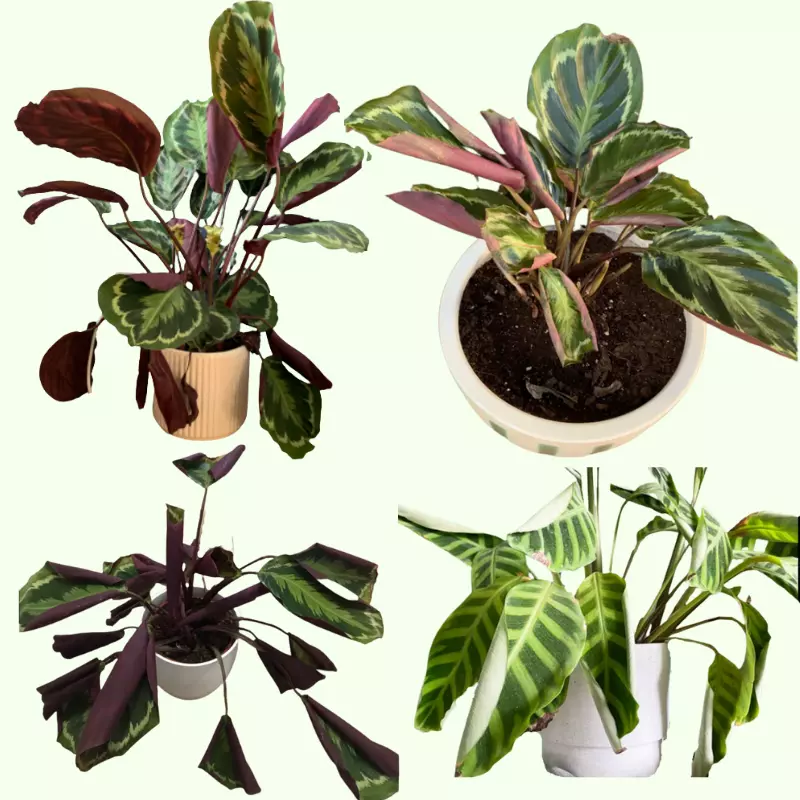
Prominent Family Members: Calathea White Star, Calathea Leopardina, Calathea Fasciata, Calathea Roseopicta, Calathea Flamestar, Calathea Lutea, Calathea Freddie
Essential Products:
Why are Your Calathea Leaves Curling?
In this article, we will talk about the reasons why Calathea leaves curls and how to treat them properly.
Following are the reasons for Calathea leaves Curling
Dehydration
Calathea plants love to grow in moist soil and atmosphere. Dehydration might be due to underwatering or less humid air. Calathea plants are hailed from the tropical forest of Brazil and require the same humidity level as they used to thrive in their native land. They need a minimum of 50% moisture to need comfortable, however, their ideal moisture level to thrive extraordinarily is 70-80%.
You can obtain the high humidity level by using a plant humidifier near your plants. It will not only help the curling issue of the leaves but also helps the unfurling of new leaves.
Signs of Dehydration
If the plant is dehydrated its leaves start curling inward to save moisture from the leaf surface. Moreover, browning of the edges and tips of the leaves also indicates dehydration. If leaves start crisping after browning it’s too late and the damage cannot be recovered even by providing the plant with the required moisture. In that case pruning of damaged leaves is recommended.
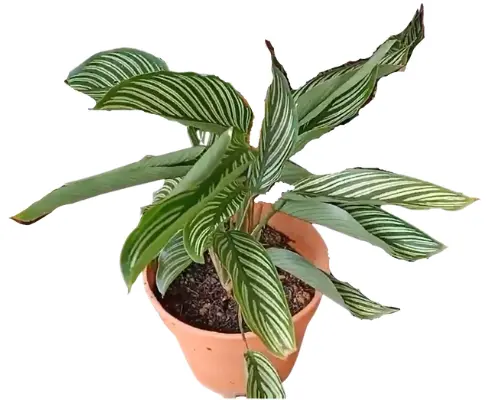
How to Save Calathea from Dehydration?
Dehydration can be easily mitigated by keeping the affected plant with other indoor plants or investing in a plant humidifier that not only produces moisture but also maintains the humidity around the plant. In addition, plants placed on a tray filled with water and pebbles can also reduce dehydration in plants.

Underwatering
Underwatering is the second reason to make plants’ leaves curl. Calatheas flourish in moist soil , whereas dry soil damages the roots of the plant. As a result ,required water is not transported to the leaves, making them start curling.
Symptoms of Underwatering
The calathea plant starts dropping its beautiful leaves, additionally, curling and browning of the leaves will start too. You can check the potting soil, if it’s dry up to two inches it indicates underwatering. Therefore, your plant is thirsty for water.
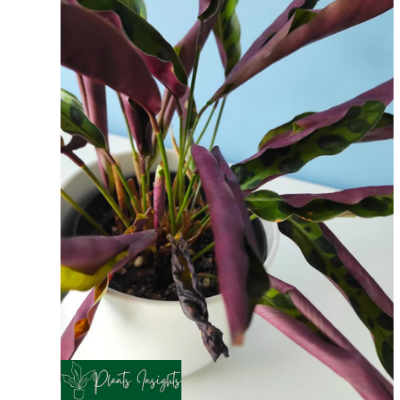
How to Save from Underwatering?
Water calathea plant immediately and let the excess water drain out from the potting soil. watering will help the plant get its rigidity back and the plant will recover soon from the underwatering damage. Prune the damaged and crispy leaves to give healthy look and a stunning look back.

Overwatering
Calathea plants demand moist soil and hate soggy or waterlogged conditions. Overwatering saturated the potting soil, which doesn’t let the breathe properly.
Symptoms of Overwatering
Yellowing and drooping leaves are classic signs of overwatering. Check if the soil is wet after two weeks or more since you watered it. We recommend to remove your Calathea from the pot and inspect its roots. If the roots are soft, mushy, and dark /brown, your Calathea has been overwatered.
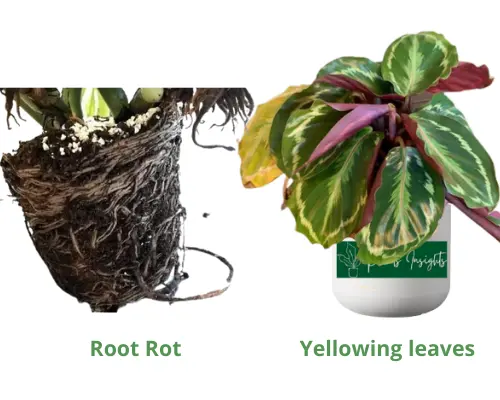
How to save from Overwatering?
Repot your Calathea with a well-draining pot with mixed moist pot soil. If roots are soft and rotted prune them with a clean sharp knife. Re water Calathea plant after the upper two-inch layer of the potting soil is dry. The best option to avoid overwatering is the use of a moisture meter.

Sunlight and Temperature
Calathea prefers medium bright light as too much light burns its beautiful leaves. We suggest not to leave your Calathea plant in direct sunlight otherwise, its leaves will scorch. In addition, it also causes browning and curling of the leaves of Calathea.
Symptoms of direct sunlight and temperature
Avoid your Calathea direct sunlight put it at that place where Calathea gets only indirect heat and sunlight. If leaves start curling inwards with brown spots it means your Calathea leaves have sunburned. Moreover, crisping, curling, and browning of the leaves also indicate the plant is in intensely bright light.
How to Save from Direct Sunlight and Temperature?
Move your Calathea plant to the shaded area with medium bright diffused light. The best indoor place for the Calathea plant is a northeast-facing window with blinds on it. outdoor place it under the shaded area or provide shade with a shade cloth.

Over-Fertilization
It is a misconception that over fertilizing will boost the plant growth, Calathea plant requires fertilizers once a month in the growing season from early spring to late summer, over-fertilizing harm your plant due to the high number of different salts and nutrients that can pull away all moisture from the roots, and plants could not absorb water properly, resulting leaves start curling and burning.
Symptoms of Over-Fertilization
If Calathea leaves edges start to curl it means it has become over-fertilized in this condition Calathea cannot absorb water due to the accumulation of the excessive number of salts on roots and water and nutrients cannot be absorbed properly and leaves start curling due to dehydration.
How to save Calathea from Over-Fertilization?
Put Calathea plant pot under running water tap for 10 minutes to flush away the excessive salts. make sure that all excess water is drained out from the pot from the drainage hole before putting it back in its permanent spot. It is recommended to use half of the total dose as per the instructional menu once a month.
Note: Water your plant before applying fertilizer in this way intensity of the salts will be more diluted.

Pest Infestation
Indoor it rarely happens that Calathea is infested by pests. The most common pests of Calathea plants are scales, spider mites, mealybugs, whiteflies, fungus gnats, and thrips that can damage Calathea leaves.
Signs of Pest Infestation
Plant parents are prone to confuse leaves damages due to pests attack with overwatering symptoms like yellowing and thinning of leaves. When Calathea is infested with spider mites, the gorgeous foliage become droopy and developed a light color stippled discoloration. If you notice small, yellowish dots on the leaves top, it is more likely under pest attack.
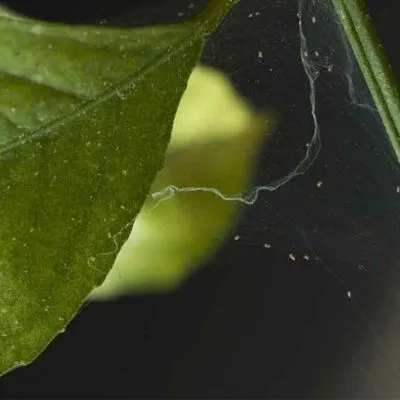
How to Get Rid of Pest Infestations?
To get rid of pest infestation you can move your Calathea plant to a more humid and shady location. In addition, wash leaves with insecticidal soap on the infested part of the plant. Apply neem oil to kill spider mites and other pests. Moreover, immediately isolate your infested Calathea from another house plants. We recommend to prune the damaged leaves to get back plant’s beautiful healthy look.

